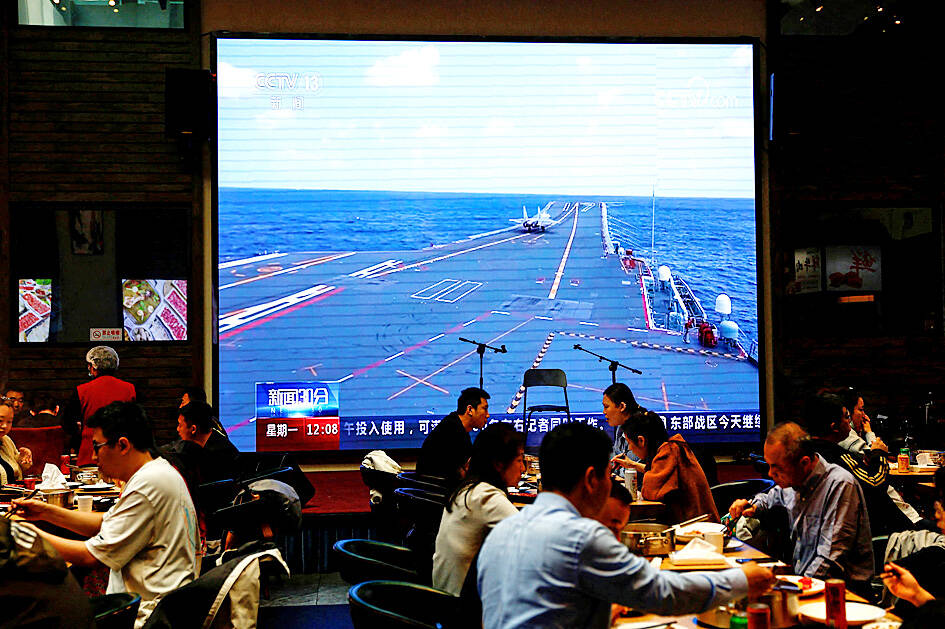The Chinese People’s Liberation Army’s (PLA) latest round of military exercises revealed a new strategy in Beijing’s campaign of intimidation against Taiwan, a defense expert said.
Last month, China launched a three-day drill following President Tsai Ing-wen’s (蔡英文) meeting with US House of Representatives Speaker Kevin McCarthy in the US, National Defense University researcher Ma Chen-kun (馬振坤) wrote in an article published in the Mainland Affairs Council’s (MAC) latest briefing.
These exercises, named “joint sword,” included 232 air sorties — 134 of which crossed the median line of the Taiwan Strait — but did not feature the use of exclusion zones or live-fire maneuvers, he said.

Photo: REUTERS
The drills suggest that the PLA has adopted a strategy to regularly and without warning conduct preparedness patrols around Taiwan proper, which cements the notion that the Taiwan Strait is part of China’s territorial waters, he said.
The intended effect of this is to compress Taiwan’s air-sea defensive depth, which allows the PLA to project power into the western Pacific Ocean, and potentially launch an invasion during a supposed patrol, Ma said.
The strategic implications of the preparedness patrols are more of a threat to Taiwan’s security than the high-profile live-fire drills of the past, due to the possibility that the PLA could use the exercises as a smokescreen for an attack, he said.
The PLA likely dispensed with firing missiles during the exercises to avoid raising unwanted attention from the international community, which was counterproductive, he said.
The Chinese forces that took part in the drills conducted rehearsals of maneuvers that would be used in an attack on Taiwan proper, he said, adding that the PLA demonstrated improved capabilities to prevent US forces from aiding the nation.
Although China’s aircraft carriers are inferior to the US’, the PLA could deploy more modern warships, submarines, and ground and air-launched anti-ship missiles, as it would be closer to the warzone, he said.
The PLA is in a stronger position against the US than ever before, and it has capacity for deterrence that it did not have during the 1996 Taiwan Strait Crisis, Ma said.
The urgency displayed by the US in efforts to stock Taiwan with secure ammunition storage is an indication of the dangers, he said.
China’s aggressive use of military exercises not only breached the tacit understanding between Taipei and Beijing to respect the median line, but also significantly increased the risk of inadvertently triggering a conflict through mishap, he said.
The PLA would likely refrain from carving out exclusion zones when it uses military drills to threaten Taiwan, to avoid international censure that disrupting sea communications would spark, he said.
Beijing would exert pressure by increasing the frequency and size of war games, he said.

The brilliant blue waters, thick foliage and bucolic atmosphere on this seemingly idyllic archipelago deep in the Pacific Ocean belie the key role it now plays in a titanic geopolitical struggle. Palau is again on the front line as China, and the US and its allies prepare their forces in an intensifying contest for control over the Asia-Pacific region. The democratic nation of just 17,000 people hosts US-controlled airstrips and soon-to-be-completed radar installations that the US military describes as “critical” to monitoring vast swathes of water and airspace. It is also a key piece of the second island chain, a string of

A magnitude 5.9 earthquake that struck about 33km off the coast of Hualien City was the "main shock" in a series of quakes in the area, with aftershocks expected over the next three days, the Central Weather Administration (CWA) said yesterday. Prior to the magnitude 5.9 quake shaking most of Taiwan at 6:53pm yesterday, six other earthquakes stronger than a magnitude of 4, starting with a magnitude 5.5 quake at 6:09pm, occurred in the area. CWA Seismological Center Director Wu Chien-fu (吳健富) confirmed that the quakes were all part of the same series and that the magnitude 5.5 temblor was

Taiwan will now have four additional national holidays after the Legislative Yuan passed an amendment today, which also made Labor Day a national holiday for all sectors. The Chinese Nationalist Party (KMT) and Taiwan People’s Party (TPP) used their majority in the Legislative Yuan to pass the amendment to the Act on Implementing Memorial Days and State Holidays (紀念日及節日實施辦法), which the parties jointly proposed, in its third and final reading today. The legislature passed the bill to amend the act, which is currently enforced administratively, raising it to the legal level. The new legislation recognizes Confucius’ birthday on Sept. 28, the

The Central Weather Administration has issued a heat alert for southeastern Taiwan, warning of temperatures as high as 36°C today, while alerting some coastal areas of strong winds later in the day. Kaohsiung’s Neimen District (內門) and Pingtung County’s Neipu Township (內埔) are under an orange heat alert, which warns of temperatures as high as 36°C for three consecutive days, the CWA said, citing southwest winds. The heat would also extend to Tainan’s Nansi (楠西) and Yujing (玉井) districts, as well as Pingtung’s Gaoshu (高樹), Yanpu (鹽埔) and Majia (瑪家) townships, it said, forecasting highs of up to 36°C in those areas